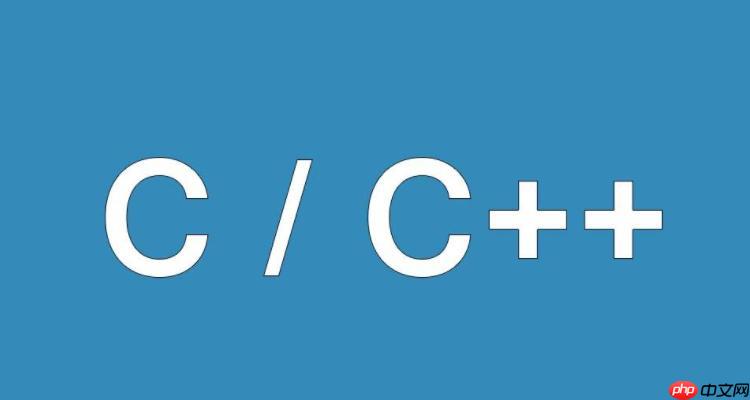在c++++中创建一个类使用class关键字,后跟类名,并在类体内定义成员变量和函数。例如:class myclass {public: int myvariable; void myfunction() {}};这个例子展示了如何定义一个简单的类myclass。

在C++中创建一个类是面向对象编程的基本操作之一。让我从回答你的问题开始,然后我们可以深入探讨如何在C++中设计和实现一个类。
在C++中创建一个类非常简单。你只需要使用class关键字,后面跟上类名,然后在类体内定义成员变量和成员函数。例如:
class MyClass {
public:
int myVariable;
void myFunction() {
// 函数体
}
};这个简单的例子展示了如何定义一个名为MyClass的类,它有一个公共的整数变量myVariable和一个公共的成员函数myFunction。
立即学习“C++免费学习笔记(深入)”;
在C++中,类不仅仅是数据的集合,它是面向对象编程的核心概念。让我们来看看如何设计和实现一个类,以及在过程中需要注意的一些关键点。
C++中的类可以包含数据成员(变量)和成员函数(方法)。你可以使用public、private和protected访问说明符来控制这些成员的访问级别。通常,数据成员被设置为private,而成员函数被设置为public,这样可以封装数据并提供接口来操作这些数据。
class Person {
private:
std::string name;
int age;
public:
void setName(const std::string& newName) {
name = newName;
}
void setAge(int newAge) {
if (newAge >= 0) {
age = newAge;
}
}
std::string getName() const {
return name;
}
int getAge() const {
return age;
}
};在这个例子中,Person类封装了name和age这两个私有数据成员,并通过公共的set和get方法来访问和修改这些数据。

启点在线企业网站管理系统是针对外贸中小企业而开发的具有简单易用,功能强大,性价比高,扩展性好,安全性高,稳定性好的单语版系统,可以加快企业网站的开发的速度和减少开发的成本.让不同的用户在懂的少许html语言的基础上,就能够快速的构建一个风格个性化而功能强大的企业网站. 主要功能模块介绍: 1.企业信息:发布介绍企业的各类信息,如公司简介,企业证书,营销网络,联系方式等,还可随意增加删除修
 165
165

类通常会有一个或多个构造函数,用于初始化对象。构造函数的名称与类名相同,可以有参数或无参数。析构函数用于在对象被销毁时执行清理操作,名称为类名前面加一个波浪号~。
class Car {
private:
std::string model;
int year;
public:
// 构造函数
Car(const std::string& carModel, int carYear) : model(carModel), year(carYear) {}
// 析构函数
~Car() {
// 清理操作
}
// 其他成员函数...
};成员函数可以定义在类体内,也可以定义在类体外。如果定义在类体外,需要使用作用域解析运算符::。
class Rectangle {
private:
double length;
double width;
public:
Rectangle(double l, double w) : length(l), width(w) {}
double area() const {
return length * width;
}
};
// 在类体外定义成员函数
double Rectangle::perimeter() const {
return 2 * (length + width);
}类可以有静态成员变量和静态成员函数。静态成员属于类本身,而不是类的实例。
class Counter {
private:
static int count;
public:
Counter() {
++count;
}
~Counter() {
--count;
}
static int getCount() {
return count;
}
};
// 静态成员变量需要在类外初始化
int Counter::count = 0;友元函数和友元类可以访问类的私有和保护成员。友元关系打破了封装,但有时为了提高代码的灵活性和效率是必要的。
class Box {
private:
double width;
public:
Box(double w) : width(w) {}
friend void printWidth(const Box& box);
};
void printWidth(const Box& box) {
std::cout << "Width of box: " << box.width << std::endl;
}C++支持类的继承和多态,这使得代码可以更具扩展性和重用性。通过继承,子类可以从父类继承成员,并可以重写父类的虚函数来实现多态。
class Animal {
public:
virtual void makeSound() const {
std::cout << "The animal makes a sound." << std::endl;
}
};
class Dog : public Animal {
public:
void makeSound() const override {
std::cout << "The dog barks." << std::endl;
}
};
class Cat : public Animal {
public:
void makeSound() const override {
std::cout << "The cat meows." << std::endl;
}
};
int main() {
Animal* animal1 = new Dog();
Animal* animal2 = new Cat();
animal1->makeSound(); // 输出: The dog barks.
animal2->makeSound(); // 输出: The cat meows.
delete animal1;
delete animal2;
return 0;
}在设计C++类时,我发现以下几点非常重要:
override关键字来重写它们。std::unique_ptr和std::shared_ptr)来避免手动管理内存。通过这些知识和经验,你应该能够在C++中自信地创建和设计类。记住,实践是掌握这些概念的最佳方式,所以多写代码,多尝试不同的设计模式和技术。
以上就是如何在C++中创建一个类?的详细内容,更多请关注php中文网其它相关文章!

每个人都需要一台速度更快、更稳定的 PC。随着时间的推移,垃圾文件、旧注册表数据和不必要的后台进程会占用资源并降低性能。幸运的是,许多工具可以让 Windows 保持平稳运行。

Copyright 2014-2025 https://www.php.cn/ All Rights Reserved | php.cn | 湘ICP备2023035733号